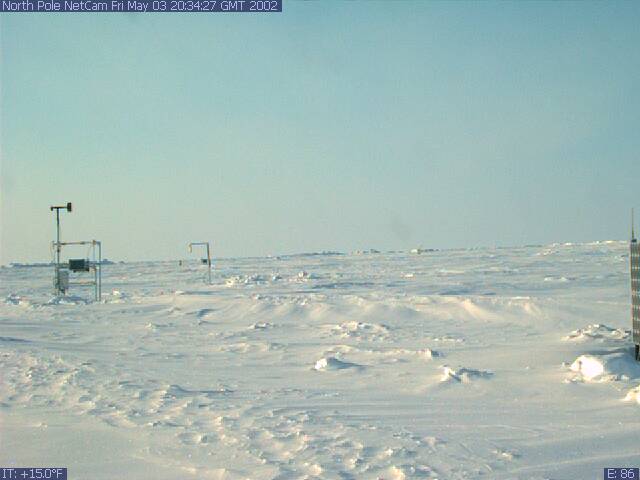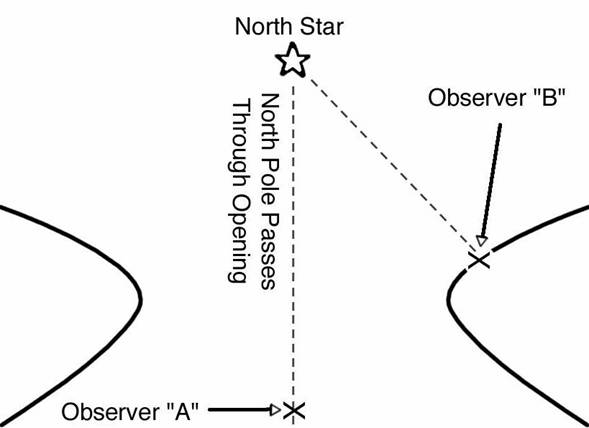

When Admiral Peary, as well as Dr. Cook, approached the North Pole, they both
reported exaggerated sledding speeds, pulled only by their Siberian husky dogs.
Why? Because the terrain not only flattened, but was curving inwards rather
sharply-
thus the photographs show foreshortening of the horizon. So a little
distance covered made for what seemed to be more-than-normal Northward progress.
This is something that showed up in their latitude calculations, and something
which was symptomatic of travel along an Earth angling inward. Thus abnormal
sledding speeds increased as Peary approached and departed from the immediate
proximity of the Pole. Right as he left, he covered a 153 miles in 48 hours,
over Arctic ice, on a sled, running over ice and snow and such. This is hardly
believable. Similar was the case of Dr. Cook.
He did tell the truth, though. It is just that the sharp, inward curving played
havoc with his latitude calculations, exaggerating his progress, and giving a
false impression of having reached the North Pole prematurely .

The following are log entries of the explorers Fridtjof Nansen, General Greely
and Admiral Peary.
You will notice that curvature anomaly has been documented from the side
of the New Siberian Islands, as well as from Northern Canada. If the inward
curvature continues from opposite sides of the Arctic circle, what happnes in
the middle? The curvature opens up and turns into the opening to the hollow
world, that's what. We quote from the authors essay From Seven Days North of
Tibet:
" On page 126 of Nansenīs book, disappointment is described as the
navigator all of the sudden determines the ships position to be various degrees
South of where they had calculated. Now, it is not reasonable to assume that an
error had existed all this time, which was not caught until that moment. Their
navigator was Sugurd Scott Hansen, an officer of the Norwegian Navy and an
academy graduate: Could it be that the current had the ship straddling the rim
of the funnel-like opening, North and back South, falsely indicating exaggerated
movements in terms of latitude? It seems that the curvature of the polar opening
was playing havoc with the angle of their sextant, and the indications derived
from the readings."
...
" Now we touch on the anomaly of curvature again-
Page 288: [ April 6th ] It became more and more of a riddle to me that we did
not make greater progress Northward. I kept on calculating and adding up our
marches later on, but always with the same result ... we must be far above the
86th parallel. It was becoming only too clear to me that the ice was moving
southward.
" Page 291: [ April 14th ] I find that we should yesterday have come
farther South than 86* 53 North; ... I cannot explain it in any other manner
than by the surmise that we have been drifting rapidly northward, which is very
good for the Fram, but less so for us [ on foot ].
" It was between these two log entries that Dr. Nansen and Johansen had
turned back. Here we find that within the space of a few days, Nansen blames his
navegational anomalies on the ice drifting Southward then Northward. More likely,
they were very close to the rim of the doughnut-like opening into the hollow
portion, and the curvature changes were confusing Dr. Nansen, indicating
paucious movement in terns of latitude, and rendering his sextant unreliable.
There was a Northward current at the time because the ship Fram, which was still
in the vicinity, had drifted Northwards also. This current would account for the
retarded Southward progress of Dr. Nansen and Johansen. But their scant
Northward/lateral progress prior to the turnback had to have been due to travel
over the curved rim of doughnut-like opening.
Culled from The Hollow Earth, page 104:
" The deep interest with which we had hitherto persued our journey was now
greatly intensified. The eye of civilized man had never seen, or his feet
trodden, the ground over which we were traveling. A strong, ernest desire to
press forward at our best speed seized us all. As we neared each projecting spur
of the land ahead, our eagerness to see what was beyond became so intense at
times as to be painful. Each point we reached brought a new landscape in sight,
and always in advance was a point which cut off a portion of the horizon and
caused a certain disappointment."
If Greely and his companions were entering into the interior of the Earth, they
would certainly find that the Earth has a greater curve near the poles than at
any other place; ... Foreshortening of the horizon can also be seen in
photographs of the North Pole area; the horizon seems to come up closer than it
should.
Admiral Peary made a similar observation: " The black cliffs peer up over
the ice caps." This indicates an exaggerated curvature, sloping inward
towards the North, that in the near distance, only the peaks of the hills popped
up into view above the horizon,
not the base of the hills.
Due to polar anomalies in terms of compass ( longitude ) and curvature (
latitude ), Dr. Nansen and crew had been unable to precisely calculate their
position since the first moment that they had lodged their ship into the ice. At
this point, trekking on foot down from the Pole, he and Johansen were still
quite unsure of their position thanks to the curvature anomalies just described,
and to the drunken compass readings along the rim of the opening. They remained
unsure for a long time as they headed straight down South on the Russian side of
the Pole. As they descended from near the Pole, however, the nature of their
navigational difficulties took on a different nature. They became problems in
terms of longitude because they had let their watches run down- not latitude.
Their difficulties in determining their longitude at this point were not
anomalous. ( As an example, by June 14th, Nansen recorded his position to be 57*
40 of longitude but, later on, once he got back to civilization, he felt that it
had been more like 6* further East of that. ) As he and Johansen headed South
towards Franz Josef Land, Dr. Nansen wasnīt even sure on which side of the
archipelago they would come down on!
As
far as the long Arctic night is concerned, a mere flattening would not account
for the existence of, or certainly not the duration of the Arctic night, where a
day can take six months to unfold.
Pages
of Interest:
Polar Warming Icebergs from the Inner Earth Ring Around the Opening
Circular, Compacted as if Linear Mammoth
Chapter Four from Gardner Radarsat ZR-1
Greenland Vikings Antarctic Ozone Image
Frobisher Map Broken Auroral Ring
Aurora Australis Marks The Spot
